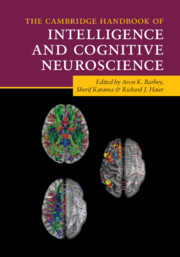Book contents
- The Cambridge Handbook of Intelligence and Cognitive Neuroscience
- Reviews
- The Cambridge Handbook of Intelligence and Cognitive Neuroscience
- Copyright page
- Dedication
- Contents
- Figures
- Tables
- Contributors
- Preface
- Part I Fundamental Issues
- 1 Defining and Measuring Intelligence
- 2 Network Neuroscience Methods for Studying Intelligence
- 3 Imaging the Intelligence of Humans
- 4 Research Consortia and Large-Scale Data Repositories for Studying Intelligence
- Part II Theories, Models, and Hypotheses
- Part III Neuroimaging Methods and Findings
- Part IV Predictive Modeling Approaches
- Part V Translating Research on the Neuroscience of Intelligence into Action
- Index
- References
3 - Imaging the Intelligence of Humans
from Part I - Fundamental Issues
Published online by Cambridge University Press: 11 June 2021
- The Cambridge Handbook of Intelligence and Cognitive Neuroscience
- Reviews
- The Cambridge Handbook of Intelligence and Cognitive Neuroscience
- Copyright page
- Dedication
- Contents
- Figures
- Tables
- Contributors
- Preface
- Part I Fundamental Issues
- 1 Defining and Measuring Intelligence
- 2 Network Neuroscience Methods for Studying Intelligence
- 3 Imaging the Intelligence of Humans
- 4 Research Consortia and Large-Scale Data Repositories for Studying Intelligence
- Part II Theories, Models, and Hypotheses
- Part III Neuroimaging Methods and Findings
- Part IV Predictive Modeling Approaches
- Part V Translating Research on the Neuroscience of Intelligence into Action
- Index
- References
Summary
Most humans can perceive the world, store information in the short- and the long-term, recover the relevant information when required, comprehend and produce language, orient themselves in known and unknown environments, make calculations of high and low levels of sophistication, and so forth. These cognitive actions must be coordinated and integrated in some way and “intelligence” is the psychological factor that takes the lead when humans pursue this goal. The manifestation of widespread individual differences in this factor is well documented in everyday life settings and has been addressed by scientific research from at least three complementary models: psychometric models, cognitive/information-processing models, and biological models.
- Type
- Chapter
- Information
- Publisher: Cambridge University PressPrint publication year: 2021

